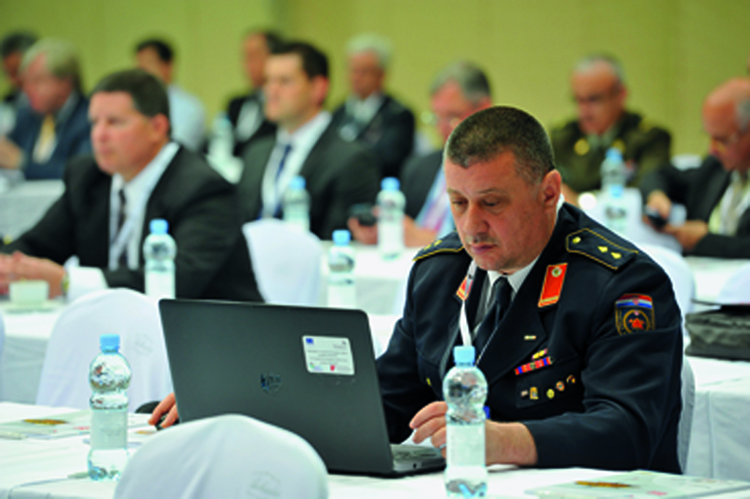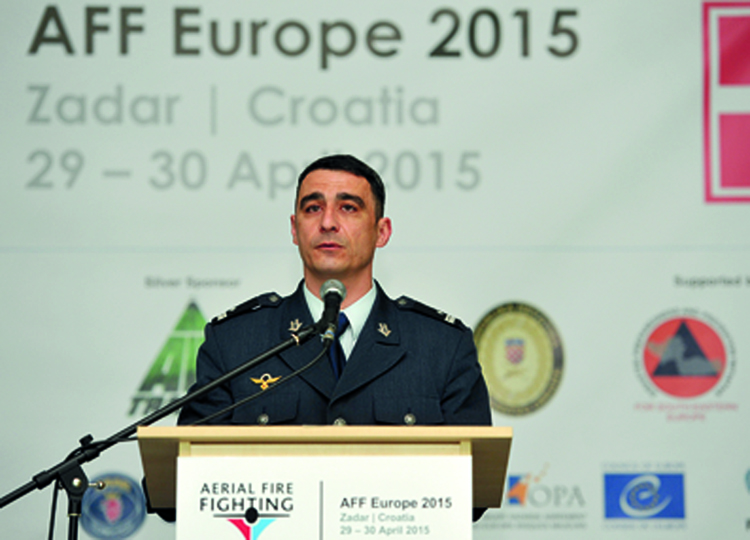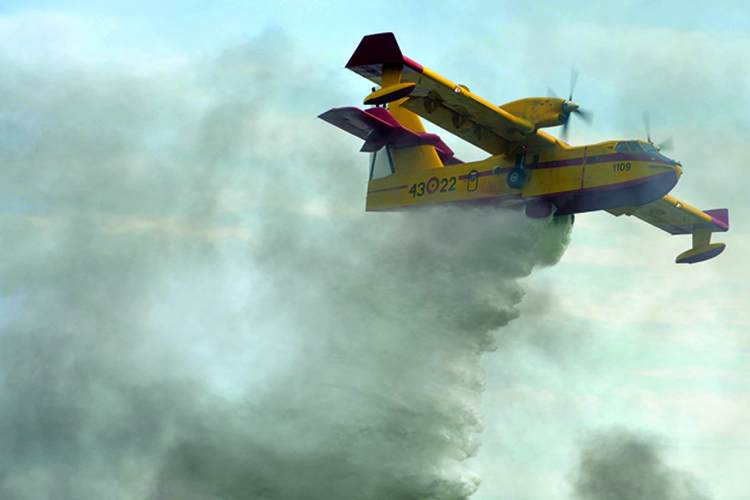A conference titled “The Croatian Defence Industry as an Export Brand“ organised by the “Jutarnji…
International Aerial Firefighting Conference – Zadar
The conference is a regular aerial firefighter event and features a wide spectrum of relevant issues. Along with Croatia as host country, the Conference was attended by 20 countries and world’s leading firefighter equipment manufacturers. Opening the Conference, the Chairman, Rear Admiral Terry Loughran stated: “I am glad that Croatia is hosting this year’s Conference, and would particularly like to point out the internationality, because co-operation and interoperability are a key in this domain“, stated Radm Loughran. The stress was laid on the interoperability and working on a common framework for optimised firefighting efficiency…

The international Aerial Fire Fighting Europe 2015 Conference, organised by the UK-based Tangent Link, with the support from the Croatian Ministry of Defene and the National Search and Rescue Directorate took place in Zadar on 29 and 30 April 2015. It was officially opened by Rear Admiral Terry Loughran, CB FRAeS of the Royal Navy, UK, who stated: „I am glad that Croatia is hosting this year’s Conference, and would particularly like to point out the internationality, because co-operation and interoperability are a key in this domain. The Conference was attended by 20 countries and exhibitors from all around the world. The stress was laid on the interoperability and working on a common framework for otpimised firefighting efficiency.
Major Davor Turković, Commander of the Firefigher Squadron and Captain on Canadair CL 415 of the Croatian Air Force and Air Defence bidded welcome to the attendees on behalf of the Croatian Defence Minister, Ante Kotromanović to Zadar “ the central place of firefighting in Croatia“. The Conference, said Major Turković, „provides an opportunity for pilots and operators to exchange the respective experiences and discuss the latest technological solutions, training and other tasks related to aerial firefighting. “We are well aware of potentially devastating impact of fires, having witnessed a number of times to fires endangering property as well as human lives. This necessitates superior co-ordination and swift action on the site. Croatia as the latest EU member latest EU member was determined to employ the available tools to create a better and safer environment. The benefit of the Conference was in constructive solutions for joint operation, while the prospective standardisation and putting in place of a common legal framework are expected to optimise international response operations.
Standardisation, guidelines and rules
Jadran Perinić, Director of the National Protection and Rescue Directorate, in his address urged co-operation at a global level, as the fire impact often exceeds individual countries capacities. “The Conference is an important opportunity to exchange the experience and expand knowledge in the domain“, said Director Perinić, who also underlined the importance of standardised regulation. He further presented the development of the fire protection and fighting in Croatia and praised the co-ordination between the National Protection and Rescue Directorate and the Ministry of Defence. The Croatian aerial firefighter forces have conducted a series of international interventions, participating in fire extinguishing operations in in Bosnia and Herzegovina, Macedonia, Greece, Israel and Portugal, and in a joint firefighting exercise in Greece.
The Director of Global Fire Monitoring Centre (GFMC), Johann Georg Goldammer covered the key topic of the Conference – a co-ordinated approach in internatioanl aerial firefighting missions. He also presented the conclusions from the interoperability workshop held on the eve of the Conference. Despite the fact that the co-operation and exchange of the capacities and resources is at a superior level, the EU still lacks a common framework for operation, producing the necessary guidelines, data bases and other co-ordination enhancers. One of the solutions considered are the prospective International Fire Aviation Guidelines and the International Manual of Common Rules for Firefighting, developed currently by the working groups of the UN International Strategy for Disaster Reduction (UNISDR).
“As we heard at yesterday’s workshop, the main shortfalls with respect to international missions are delayed arrival to the fire site, hardened communication, inexistence of common standards nor guidelines for interoperability, including the co-ordination with the ground forces. That is why we have to address the issue and support the development of common guidelines and rules“, stated Director Goldammer.
Unmanned aerial and ground vehicles
An additional obstacle to efficient firefighting are the mine-contaminated areas in the region, but also in Germany and France (where unexploded mines from the WWII are found). The problem is addressed by employing new and innovative technology solutions, such as remotely operating fire fighting tanks.
The Conference participants addressed the example of the fire occuring in Chernobyl coinciding with the conference, whose extinguishing was aggravated by the contaminated vegetation. The focus in the future situations of the kind could be on remotely operated firefighting vehicles or unmanned helicopters; one such model is being tested.
The aerial firefighting conference is the regular annual event for firefighter experts. It features a broad spectrum of issues related to aerial firefighting presented by domestic and visiting presenters. This year’s conference in Zadar is attended by representatives from 20 countries and the leading international firefighting and prevention technology and equipment, among whom the DynCorp International, Inaer, Air Tractor, Saab and others. The visitors were also able to see the novelties in the aerial firefighting technology.
The conference and the static display were set in the Višnjik Sport Centre, while the live demonstration was organised in the 93rd Base at Zemunik, where the visitors were shown the entire inventory of firefighter aircraft of the Croatian Air Force and Air Defence.
 “The Conference provides an opportunity for pilots and operators to exchange the respective experiences and discuss the latest technological solutions, training and other tasks related to aerial firefighting. We are all well aware of the potentially devastating impact of fires, having witnessed a number of times to fires endangering property as well as human lives. This necessitates superior co-ordination and swift action on the site“, said Major Davor Turković, Commander of the Firefighter Squadron.
“The Conference provides an opportunity for pilots and operators to exchange the respective experiences and discuss the latest technological solutions, training and other tasks related to aerial firefighting. We are all well aware of the potentially devastating impact of fires, having witnessed a number of times to fires endangering property as well as human lives. This necessitates superior co-ordination and swift action on the site“, said Major Davor Turković, Commander of the Firefighter Squadron.
Major Turković stressed that Croatia as the latest EU member was determined to employ the available tools to create a better and safer environment. The benefit of the Conference therefore is in producing solutions to achieve ever better and more systematic fire prevention and fighting and enable more efficient international operation.
 CROATIAN AERIAL FIREFIGHTER FORCES
CROATIAN AERIAL FIREFIGHTER FORCES
Firefighter Squadron in the Zemunik Barracks:
6 Air Tractors AT 802 (four amphibious and two wheeled)
6 Canadairs CL-415
Transport Helicopter Squadron in the „Knez Trpimir“ Barracks at Divulje:
2 Mi-8 MTV-1 helicopters (more engaged as necessary)
By procuring the new Air Tractor AT-802 Fireboss two-seater aircraft, the Ministry of Defence enabled the Air Force and Air Defence to train foreign pilots on the aircraft. Only a few European countries have developed that capability.
EU Civil Protection Mechanism in Aerial Firefighting – a voluntary fire protection pool
Dimitrios Pagidas of the European Commission’s Humanitarian aid and Civil Protection Department (ECHO) presented the EU Civil Protection Mechanism in Aerial Firefighting, with the emphasis on its perspective and upgrade. The Mechanism comprises 33 countries and serves as framework applicable with diverse types of disasters, fires among the most common.
The system works by submitting requests for assistance to the Brussels headquarters, which forwards the m to any country capable of providing it. The Headquarters co-ordinates the assistance and the European Commission reimburses up to 55% of transportation expenses to the delivering country. The mechanism is based on ad hoc decision making and displays many shorfalls.
In Mr Pagidas’s view the objective is to design a new concept of operation based on the current planning practice to optimise the use of the resources. He briefly introduced a new concept of response devised as a “volunteer pool“, whereby member countries would previously submit requests and get certified for assistance in the event of request, and would in return be reimbursed up to 85% of transport expenses and 100% of expenses for the necessary adjustments .
